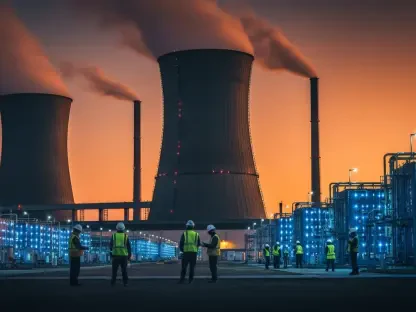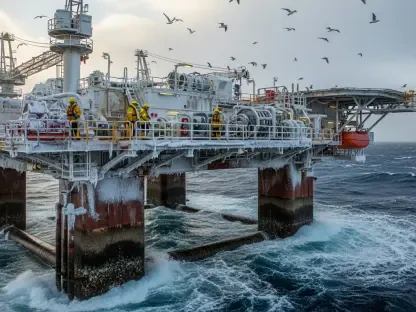Imagine a vast expanse of ocean off the coast of China, where nearly six million solar panels bob gently on the waves, harnessing the sun’s power in a way that defies traditional energy production, showcasing a bold leap into renewable innovation. This awe-inspiring scene is not a vision of the future but a reality in Dongying, Shandong Province, where an ambitious offshore solar farm stretches across 1,223 hectares. Supported by thousands of photovoltaic platforms, this project stands as a testament to innovative engineering and a bold response to the pressing challenge of meeting energy demands in a densely populated nation. With limited land available for conventional solar installations, China has turned to the sea, pioneering a solution that could redefine renewable energy on a global scale. This endeavor not only addresses immediate power needs but also signals a significant shift toward sustainable practices, capturing the attention of energy experts and environmentalists worldwide.
Breaking New Ground in Renewable Energy
Harnessing Solar Power on the Open Ocean
China’s latest venture into renewable energy pushes boundaries by placing solar farms far from the safety of calm bays or reservoirs, directly into the challenging environment of the open ocean. Located hours from the shore, these floating megafarms face relentless saltwater corrosion, powerful waves, and gale-force winds, testing the limits of engineering ingenuity. The design incorporates nearly 3,000 photovoltaic platforms with steel truss foundations, ensuring stability against harsh marine conditions. This strategic placement maximizes space efficiency, a critical factor in a country where land scarcity poses a constant barrier to development. Beyond merely generating power, the project reflects a commitment to diversifying energy sources, reducing dependency on coal, and tackling the dual challenges of urbanization and environmental impact. As a result, this initiative offers a glimpse into how technology can adapt to seemingly insurmountable obstacles, potentially setting a new standard for energy production in coastal regions around the globe.
Engineering Feats Amid Marine Challenges
The technical prowess behind these offshore solar arrays cannot be overstated, as they must endure conditions far more punishing than their land-based counterparts. Advanced materials resistant to corrosion, robust anchoring systems to withstand tidal movements, and sophisticated cable engineering for power transmission are just a few of the innovations at play. A 66 kV offshore cable connects the farm to an onshore grid, facilitating the delivery of an estimated 1.78 terawatt-hours of electricity annually. This output holds the promise of significantly curbing carbon emissions, particularly in densely populated coastal areas where energy demand is highest. However, the marine environment introduces complexities, such as the need for constant monitoring to prevent structural failures under extreme weather. These engineering solutions, while impressive, highlight the delicate balance between pushing technological limits and ensuring long-term reliability in an unforgiving setting, raising questions about scalability and cost-effectiveness.
Impacts and Implications for the Future
Environmental and Energy Benefits in Focus
One of the most compelling aspects of China’s floating solar farms is their potential to transform energy dynamics while addressing environmental concerns. By generating substantial renewable power, the project directly contributes to reducing reliance on fossil fuels, a critical step in combating climate change. The strategic arrangement of panels minimizes shadowing and wave interference, optimizing energy production without compromising the surrounding ecosystem. Authorities maintain that marine life beneath the platforms could even thrive, potentially creating new habitats, though continuous monitoring remains essential to validate these claims. In coastal regions, where energy needs often outstrip supply, this initiative enhances security and sustainability, offering a model that balances human demand with ecological responsibility. The reduction in land use pressure further amplifies the appeal, freeing up valuable terrestrial space for agriculture and urban growth, a benefit that resonates deeply in a nation facing such constraints.
Navigating Risks and Global Influence
While the benefits are undeniable, the risks associated with maintaining solar farms at sea present significant hurdles that cannot be ignored. Maintenance costs are notably higher in marine environments, where accessing and repairing equipment amid unpredictable conditions adds layers of logistical complexity. The panels must endure constant exposure to harsh elements, raising concerns about durability and the long-term feasibility of such projects. Additionally, the environmental impact on marine ecosystems requires rigorous study to ensure no unintended harm occurs over time. Globally, the outcome of this endeavor in Dongying is being closely watched, as it could serve as a blueprint for other nations considering offshore solar solutions. Should the challenges be adeptly managed, this pioneering effort might inspire a wave of similar initiatives, reshaping how renewable energy is harnessed worldwide. The cautious optimism surrounding the project underscores the need for sustained innovation and vigilance as this technology evolves.
Shaping a Sustainable Path Forward
Reflecting on the journey of China’s offshore solar megafarms, the initiative in Dongying emerged as a bold experiment that challenged conventional approaches to renewable energy. It demonstrated how necessity could drive groundbreaking solutions, with millions of solar panels deployed across the ocean to meet escalating energy needs. The project’s design and execution showcased remarkable engineering achievements, even as it grappled with the harsh realities of marine conditions. Looking ahead, the focus must shift to refining maintenance strategies, enhancing material durability, and conducting thorough environmental assessments to ensure lasting success. International collaboration could play a vital role, sharing insights and technologies to overcome shared challenges. As nations seek scalable, sustainable energy options, the lessons learned from this endeavor offer a roadmap for balancing innovation with responsibility, paving the way for a cleaner, more resilient energy future on a global scale.









